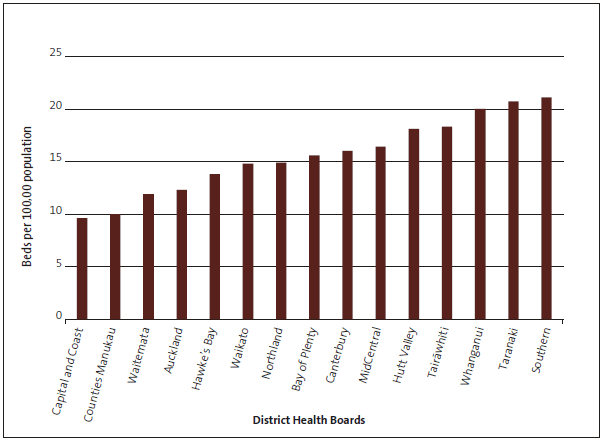Part 2: Acute mental health care
2.1
In this Part, we describe:
- the organisations with a role in providing mental health care;
- patterns of contact with mental health services; and
- mental health funding.
Organisations with a role in providing mental health care
The Ministry of Health
2.2
The Ministry sets the overall strategy for mental health, including outcome frameworks, high-level standards, and performance expectations. The Ministry also allocates funding to DHBs and monitors their performance.
2.3
The Ministry told us that it is working with other government agencies to consider how government can better respond to mental health needs and support well-being for a range of population groups. This work will have a broad focus and is expected to lead to improvements to a person's mental health and well-being after they are discharged from an inpatient unit.
District health boards
2.4
DHBs provide specialist mental health services. They provide some services directly, such as hospitals' inpatient facilities, and some community-based services. DHBs also contract some services to non-governmental organisations and private providers.
2.5
When people are discharged from an inpatient unit, most are discharged to a community-based mental health service. Each person will receive a different combination of services and care to meet their individual needs. A few people are discharged to another type of service, such as their GP. Occasionally, people do not have any type of follow-on service after their stay in an inpatient unit, based on assessment or by their own choice.
Non-governmental organisations
2.6
Non-governmental organisations also provide community-based services on behalf of DHBs. These services can include respite or residential facilities and day programmes, as well as therapies and other types of support for people living in their own homes.
General practitioners and other primary care providers
2.7
A GP is often the first contact with a medical professional for someone with a mental health problem. Most people will need to receive care only from their GP, but if required a GP will refer someone to more specialised services. A person can also be returned to a GP's care when they are discharged after a hospital stay. Primary mental health care is also sometimes provided by other types of practitioner such as mental health co-ordinators and nurse practitioners.
Private providers
2.8
Private providers include specialist practitioners, such as psychiatrists, and facilities such as rehabilitation clinics. These are outside the scope of our audit.
Patterns of contact with mental health services
2.9
Our audit focused on a relatively small group of people with high and complex needs. Each individual in this group had a unique combination of mental health conditions, general health conditions, and personal circumstances. This means that each person had a unique set of needs and corresponding service requirements.
2.10
Each DHB provides mental health services differently, too. We explain these differences in the next few paragraphs. Together, this means that each person had a different pattern of contact with mental health services – we did not expect to see everyone receiving the same services in the same way. Instead, we expected DHBs to deliver services in a way that met the needs of each person with acute mental health problems.
2.11
An example of differences in how DHBs organise mental health services is the provision of acute care. All DHBs have a hospital-based inpatient unit for people needing acute care,4 but each DHB structures its inpatient unit in a different way. For example, as shown in Figure 4, there is considerable variation in the number of beds in inpatient units compared to population size. There will also be different numbers of secure, intensive care, and non-secure beds in each inpatient unit.
Figure 4
Number of beds in inpatient units for every 100,000 of population, by district health board

Note: Data were available for 15 of the 20 DHBs. Wairarapa DHB does not have an inpatient unit. Data from the other four DHBs were not available.
Source: Our analysis of DHB Key Performance Indicator Programme data.
2.12
Beyond inpatient units, DHBs provide different types of services. For example, some DHBs provide a sub-acute unit as a step between the inpatient unit and community-based care.
2.13
Each DHB also serves a different population. Some DHBs have a large, ethnically diverse, high-density, urban population. Others have a smaller population spread over large rural areas. This affects the types of services that DHBs need to provide and the best way of structuring their services.
Mental health funding
2.14
The total "ring-fenced" funding for the Ministry and DHBs to spend on mental health and addiction services for the last three years was:
- $1.296 billion in 2013/14;
- $1.372 billion in 2014/15; and
- $1.407 billion in 2015/16.
2.15
This represents around 9% of the total Vote Health budget.
4: Wairarapa DHB provides this service through another DHB's facilities.

